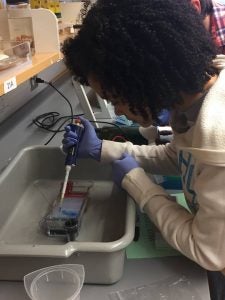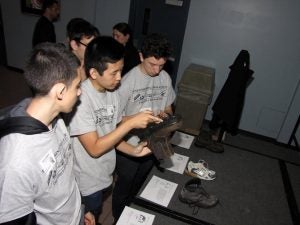 This year, over 100 SMILE students participated in SMILE’s 23rd annual High School Challenge Weekend. Students arrived at the University of Rhode Island on Friday, March 31st, from Central Falls, Newport, Pawtucket (Shea and Tolman), South Kingston, Westerly, West Warwick, and Woonsocket. Each team (investigative unit) was tasked with solving the case of the missing plant. This was SMILE’s first time doing a forensics-themed challenge. It was a huge success.
This year, over 100 SMILE students participated in SMILE’s 23rd annual High School Challenge Weekend. Students arrived at the University of Rhode Island on Friday, March 31st, from Central Falls, Newport, Pawtucket (Shea and Tolman), South Kingston, Westerly, West Warwick, and Woonsocket. Each team (investigative unit) was tasked with solving the case of the missing plant. This was SMILE’s first time doing a forensics-themed challenge. It was a huge success.
Dennis Hilliard, Director of the Rhode Island State Crime Lab, which is housed at URI, welcomed the students. He discussed how the Crime Lab operates and the science that is done there. Mr. Hilliard also discussed professions in the forensics field and the education path to get there. He recommends a strong chemistry foundation.
students were then presented with the challenge. Each investigative unit was given an “Evidence File” with background information about the crime and profiles of each of the five suspects. The story of the crime was dramatically presented by Claire Wilson, SMILE’s Program Coordinator. Students had to work together throughout the day to figure out who stole the rare Japanese chrysanthemum bonsai from the Rhode Island Horticultural Museum based on the evidence that was left behind. The plant has an estimated value of 2.6 million dollars.
Students rotated through four laboratory investigations to gather data. These labs included: (1) fingerprints, (2) shoe prints, (3) DNA electrophoresis, and (4) trace evidence. Jo Don Edwards, who works in the Latent Prints department at the State Crime Lab, facilitated the fingerprinting lab. Students learned how to identify different types of fingerprints and dusted for prints left behind at the crime scene. They were then able to compare the crime scene prints to those of the five suspects. Detective Sean Gorman of the Lincoln Police Department facilitated the shoe print lab. Students learned about visible, plastic, and latent prints before investigating the prints left behind at the crime scene. They were able to photograph the crime scene prints as well as the suspects’ shoes. Students learned that shoe prints are only a small piece of the puzzle when working to solve a crime. Students were urged to pay attention to detail, including foot direction, tread design, size, wear patterns, cuts, gouges, cracks, and foreign debris (rocks, tacks, glass, etc.).
The DNA electrophoresis and trace evidence labs took place in the state of the art labs in URI’s Center for Biotechnology and Life Sciences. Thank you to Linda Forrester, manager of the undergraduate biology labs, for allowing SMILE to utilize the labs and equipment. During the DNA electrophoresis lab, students learned how to use a micro pipette and load gels with DNA from the crime scene and the five suspects. They “ran” their gels to figure out whose DNA was left at the crime scene. During the trace evidence lab, students looked at hair, fiber, and pollen samples underneath microscopes. They were able to compare the evidence left at the crime scene to those of the suspects.
As usual, volunteer mentors were an integral part of the event. URI students from different organizations, as well as professionals from Amgen, Women in Transportation, and Steere Engineering were excellent role models and helped make the event a success.
After eating dinner in the dining hall, students came back to the Memorial Union to work together in their investigative units to analyze their data in order to figure out who committed the crime. They were able to narrow the field of suspects and ruled out anyone not supported by the data. They then presented their conclusions in an open mic format, where students gathered around and cheered each other on. Students had a lot of fun formulating their conclusions. Turns out, all teams got it right!
Once the long day of laboratory investigations was complete, SMILE students enjoyed some much-deserved downtime in the URI pool and on the Keaney basketball courts before heading to the Holiday Inn in South Kingstown.
On Saturday, students rotated through two panels – student pathways and career pathways. During the student panel, six motivated URI students shared what it’s like to be a college student, financial and scholarship information, studying tips, extracurricular activities, internship and fellowship opportunities, details about the Talent Development program, and even tips about dorm life and roommates. The professional panel was just as helpful. Professionals from the field shared their personal stories about their education and career paths. SMILE students asked great questions and learned that there are a lot of ways to be successful.
To wrap up, Dr. Patricia Ogera, M.D., from the State Medical Examiners Office, was our keynote speaker. Dr. Ogera shared her inspiring story about going to school in NYC and getting into the forensics field. Dr. Ogera specializes in forensic pathology. She spoke of the details of her daily work. Students were excited to learn about another career option.
It was another successful challenge weekend that gave students a unique and authentic experience. Coming to a college campus, interacting with college and industry mentors, accomplishing a challenging task, and working with other motivated students from around the state are just a few of the major highlights that SMILE students get to experience to set them on a pathway to college and success. Of course, it’s bittersweet to see our seniors move on from high school and SMILE to college; we are going to miss their enthusiasm but we’re excited to hear about their many successes. We’re also excited for the freshmen, sophomores, and juniors to return to SMILE next year to build on what they’ve learned and be excellent role models for the younger students. Of course, a special thanks also goes to Amgen, van Beuren Family Foundation, Verizon, Rhode Island Foundation, and Lloyd G. Balfour Foundation – whose funding support made this event possible.

